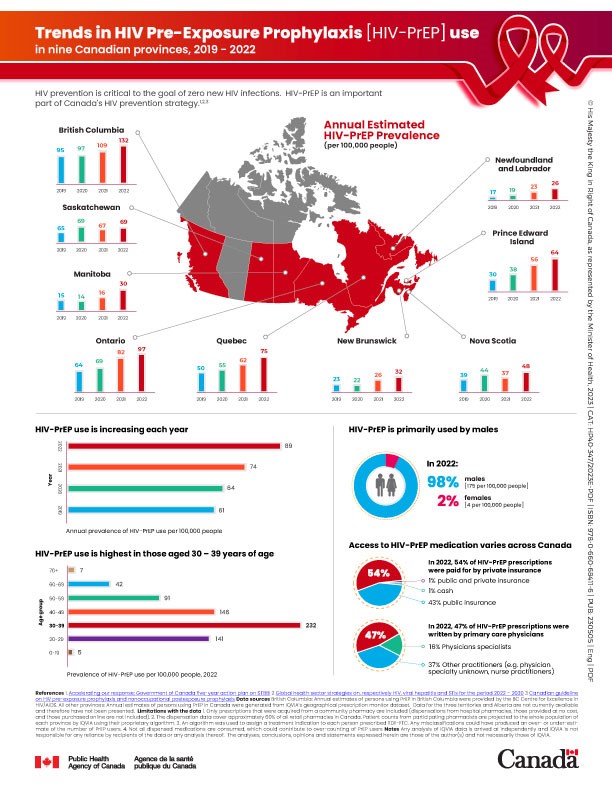Trends in HIV Pre-Exposure Prophylaxis [HIV-PrEP] use in 9 Canadian provinces, 2019 – 2022 [Infographic]
Download in PDF format
(429 KB, 1 page)
Organization: Public Health Agency of Canada
Date published: November 2023
Cat.: HP40-347/2023E-PDF
ISBN: 978-0-660-68411-6
Pub.: 230505
HIV prevention is critical to the goal of zero new HIV infections. HIV-PrEP is an important part of Canada's HIV prevention strategy.Footnote 1Footnote 2Footnote 3
| Year | 2019 | 2020 | 2021 | 2022 |
|---|---|---|---|---|
| Manitoba | 15 | 14 | 16 | 30 |
| New Brunswick | 23 | 22 | 26 | 32 |
| Newfoundland and Labrador | 17 | 19 | 23 | 26 |
| Nova Scotia | 39 | 44 | 37 | 48 |
| Ontario | 64 | 69 | 82 | 97 |
| Prince Edward Island | 30 | 38 | 56 | 64 |
| Quebec | 50 | 55 | 62 | 75 |
| Saskatchewan | 65 | 69 | 67 | 69 |
| British Columbia | 95 | 97 | 109 | 132 |
| Year | 2019 | 2020 | 2021 | 2022 |
|---|---|---|---|---|
| PrEP use prevalence | 61 | 64 | 74 | 89 |
| Age groups | Rate [per 100,000 people] |
|---|---|
| 0 - 19 | 5 |
| 20 - 29 | 141 |
| 30 – 39 | 232 |
| 40 – 49 | 146 |
| 50 - 59 | 91 |
| 60 - 69 | 42 |
| 70+ | 7 |
HIV-PrEP is primarily used by males
- In 2022, 98% of HIV-PrEP was used by males, while 2% was used by females.
- The rate of HIV-PrEP use among males was 175 per 100,000 people.
- The rate of HIV-PrEP use among females was 4 per 100, 000 people.
Access to HIV-PrEP medication varies across Canada
- In 2022, 54% of HIV-PrEP prescriptions were paid for by private insurance, 43% was paid for by public insurance, 1% by cash and 1% by combined private and public insurance.
- In 2022, 47% of HIV-PrEP prescriptions were written by primary care physicians, whereas 16% were written by physician specialists and 37% by other practitioners [e.g. physician specialty unknown, nurse practitioners].
Footnotes
Data sources British Columbia: Annual estimates of persons using PrEP in British Columbia were provided by the BC Centre for Excellence in HIV/AIDS. All other provinces: Annual estimates of persons using PrEP in Canada were generated from IQVIA's geographical prescription monitor dataset. Data for the three territories and Alberta are not currently available and therefore have not been presented.
Data Limitations 1. Only prescriptions that were acquired from a community pharmacy are included (dispensations from hospital pharmacies, those provided at no cost, and those purchased online are not included). 2. The dispensation data cover approximately 60% of all retail pharmacies in Canada. Patient counts from participating pharmacists are projected to the whole population of each province by IQVIA using their proprietary algorithm. 3. An algorithm was used to assign a treatment indication to each person prescribed TDF-FTC. Any misclassifications could have produced an over- or under-estimate of the number of PrEP users. 4. Not all dispensed medications are consumed, which could contribute to over-counting of PrEP users
Notes Any analysis of IQVIA data is arrived at independently and IQVIA is not responsible for any reliance by recipients of the data or any analysis thereof. The analyses, conclusions, opinions and statements expressed herein are those of the author(s) and not necessarily those of IQVIA.
Page details
- Date modified:
